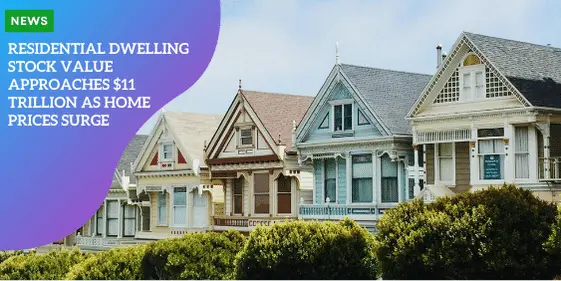Residential Dwelling Stock Value Approaches $11 Trillion as Home Prices Surge

According to recent data released by the Australian Bureau of Statistics (ABS), the total value of Australian residential dwellings has hit a new all-time high, climbing to a remarkable $10.7 trillion during the March quarter.
This milestone underscores the ongoing dynamics and pressures within the Australian real estate market.
Tuesday’s report from the ABS revealed that the total value of residential properties increased by $209.4 billion in the first quarter of 2024.
This remarkable jump brought the average home value to $959,300, marking a rise of $14,300 within just three months.
The data further accentuated that of the $10.7 trillion in residential building value, a substantial $10.3 trillion is owned by households.
Regional Analysis: Winners and Losers
Across the nation, the quarterly rise in housing values displayed regional variations, with New South Wales (NSW) registering the highest mean house price at an impressive $1.2 million.
On the other end of the spectrum, the Northern Territory recorded the lowest average value at $511,400, showcasing the diverse property market conditions across different states and territories.
Western Australia’s property market experienced the most significant increase, with average house values climbing by 5.4 percent, equivalent to $39,200, over the quarter.
In contrast, Victoria’s housing market faced a slight downturn, with the mean dwelling value decreasing by 0.2 percent, or $1,600.
This decline in Victoria marks a deviation from the broader national trend of rising home values.
Housing Stock and Population Dynamics
The number of new homes witnessed a notable increase over the quarter, rising by 52,700 to reach a total of 11.2 million homes.
However, this increase was eclipsed by Australia’s rapid population growth, which saw an addition of 178,600 people during the same period.
To maintain the average number of residents per dwelling at a stable 2.5, the housing stock would have needed to increase by 71,440 in the March quarter alone.
Economic Factors Influencing the Market
The rise in home prices persists despite several economic factors that would typically dampen demand.
The Reserve Bank of Australia’s (RBA) aggressive interest rate hikes, coupled with elevated inflation, would generally exert downward pressure on property values.
However, a recent lackluster trend in home starts and completions has bolstered average prices, reflecting the nuanced interaction of supply and demand forces in the housing market.
Challenges Ahead for Housing Supply
The fresh data amplifies already growing concerns from various quarters—including the construction industry, policy experts, and the government’s independent housing supply council—about meeting the ambitious targets set by the federal government.
Labor’s target to build 1.2 million well-located homes over the five years leading up to mid-2029 faces significant hurdles unless there is a substantial increase in new home building activities.
The shortfall in housing stock that’s keeping pace with the population growth implies a persistent demand pressure on housing prices.
This demographic and economic dynamic necessitates proactive measures and strategic planning to address the looming housing shortage, which if left unchecked, can exacerbate the challenges of affordable housing and living costs for many Australians.
Strategic Responses and Policy Implications
Addressing the housing supply shortfall requires concerted efforts and strategic policies.
The data suggest that substantial investments in residential construction and infrastructure are paramount.
Policymakers need to focus on incentivizing home building through supportive regulations, financial subsidies, and streamlined approval processes to stimulate the market.
The policy framework must adapt to mitigate the supply-demand imbalances that fuel property value inflation.
One potential approach is adopting urban densification strategies, particularly in high-demand regions.
Enhancing the availability of high-density residential zones could alleviate the pressure on housing prices by increasing supply in key areas.
Moreover, integrating well-located housing projects that are close to employment hubs, public transportation, and essential amenities could significantly address the housing needs of a growing population.
Economic Forecasts and Future Trends
Economic analysts widely regard the burgeoning value of residential dwellings as both a reflection of the current housing market dynamics and a portent of challenges ahead.
While the ongoing appreciation of home values underscores robust investor confidence and demand, it also exacerbates concerns about housing affordability.
As policymakers grapple with striking a balance between fostering market growth and ensuring accessibility, the focus will inevitably shift towards sustainable long-term solutions.
Looking ahead, the interplay between interest rates, construction rates, and population growth remains critical in shaping the housing market’s trajectory.
If construction rates do not keep pace with population growth, the resultant supply constraints could perpetuate the trend of rising home values.
Conversely, a stabilized balance between supply and demand, facilitated by strategic construction projects, can mitigate rapid price escalations and foster a more balanced market environment.
Impact on Homeowners and Investors
For homeowners, the soaring property values translate into substantial home equity, offering opportunities for refinancing, selling, or leveraging assets for financial gain.
However, for potential homebuyers, particularly first-time buyers, the escalating prices represent formidable barriers to entry, underscoring the need for targeted financial assistance and support programs.
Investors, on the other hand, may find the rising property values appealing for portfolio diversification and capital gains.
Yet, the market’s volatility, influenced by economic policies and demographic trends, necessitates a strategic approach to property investments.
An informed perspective on market conditions, coupled with prudent financial planning, remains essential for navigating the market effectively.
Conclusion
The unprecedented surge in the value of Australia’s residential dwelling stock to nearly $11 trillion epitomizes the current pressures and dynamics within the housing market.
As the nation grapples with unprecedented population growth and rising living costs, the housing sector’s trajectory is poised at a crucial juncture.
Strategic, well-coordinated efforts to boost housing supply, coupled with responsive economic policies, will be instrumental in ensuring a balanced, sustainable market.
The challenge lies in harmonizing growth with accessibility, aiming for a future where both homeowners and potential buyers can thrive within an equitable and vibrant housing economy.
As stakeholders across the spectrum—from policymakers and industry players to homeowners and potential buyers—navigate these complexities, the shared objective remains clear: to foster a resilient housing market that aligns with Australia’s growth and economic aspirations.
By expanding the scope of the original article, including in-depth analysis and contextual backdrops, the rewritten piece offers a comprehensive overview of the residential market dynamics in Australia.
Employing a blend of passive voice and transition phrases enhances readability, aligning with SEO best practices to ensure broader engagement and information accessibility.






